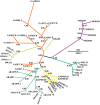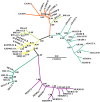Anopheles immune genes and amino acid sites evolving under the effect of positive selection
- PMID: 20126662
- PMCID: PMC2811201
- DOI: 10.1371/journal.pone.0008885
Anopheles immune genes and amino acid sites evolving under the effect of positive selection
Abstract
Background: It has long been the goal of vector biology to generate genetic knowledge that can be used to "manipulate" natural populations of vectors to eliminate or lessen disease burden. While long in coming, progress towards reaching this goal has been made. Aiming to increase our understanding regarding the interactions between Plasmodium and the Anopheles immune genes, we investigated the patterns of genetic diversity of four anti-Plasmodium genes in the Anopheles gambiae complex of species.
Methodology/principal findings: Within a comparative phylogenetic and population genetics framework, the evolutionary history of four innate immunity genes within the An. gambiae complex (including the two most important human malaria vectors, An. gambiae and An. arabiensis) is reconstructed. The effect of natural selection in shaping the genes' diversity is examined. Introgression and retention of ancestral polymorphisms are relatively rare at all loci. Despite the potential confounding effects of these processes, we could identify sites that exhibited dN/dS ratios greater than 1.
Conclusions/significance: In two of the studied genes, CLIPB14 and FBN8, several sites indicated evolution under positive selection, with CLIPB14 exhibiting the most consistent evidence. Considering only the sites that were consistently identified by all methods, two sites in CLIPB14 are adaptively driven. However, the analysis inferring the lineage -specific evolution of each gene was not in favor of any of the Anopheles lineages evolving under the constraints imposed by positive selection. Nevertheless, the loci and the specific amino acids that were identified as evolving under strong evolutionary pressure merit further investigation for their involvement in the Anopheles defense against microbes in general.
Conflict of interest statement
Figures




Similar articles
-
The molecular evolution of four anti-malarial immune genes in the Anopheles gambiae species complex.BMC Evol Biol. 2008 Mar 6;8:79. doi: 10.1186/1471-2148-8-79. BMC Evol Biol. 2008. PMID: 18325105 Free PMC article.
-
Population genetics of Anopheles coluzzii immune pathways and genes.G3 (Bethesda). 2014 Dec 30;5(3):329-39. doi: 10.1534/g3.114.014845. G3 (Bethesda). 2014. PMID: 25552603 Free PMC article.
-
SNP discovery and molecular evolution in Anopheles gambiae, with special emphasis on innate immune system.BMC Genomics. 2008 May 19;9:227. doi: 10.1186/1471-2164-9-227. BMC Genomics. 2008. PMID: 18489733 Free PMC article.
-
Comparative and functional genomics of the innate immune system in the malaria vector Anopheles gambiae.Immunol Rev. 2004 Apr;198:127-48. doi: 10.1111/j.0105-2896.2004.0127.x. Immunol Rev. 2004. PMID: 15199960 Review.
-
[Malaria vectors: from the field to genetics. Research in Africa].Rev Epidemiol Sante Publique. 2005 Jun;53(3):283-90. doi: 10.1016/s0398-7620(05)84605-x. Rev Epidemiol Sante Publique. 2005. PMID: 16227915 Review. French.
Cited by
-
Susceptibility of Anopheles sinensis to Plasmodium vivax in malarial outbreak areas of central China.Parasit Vectors. 2013 Jun 14;6:176. doi: 10.1186/1756-3305-6-176. Parasit Vectors. 2013. PMID: 23768077 Free PMC article.
-
Molecular population genetics of the NADPH cytochrome P450 reductase (CPR) gene in Anopheles minimus.Genetica. 2014 Aug;142(4):295-315. doi: 10.1007/s10709-014-9775-4. Epub 2014 Jul 20. Genetica. 2014. PMID: 25038863
-
Nature of selection varies on different domains of IFI16-like PYHIN genes in ruminants.BMC Evol Biol. 2019 Jan 17;19(1):26. doi: 10.1186/s12862-018-1334-7. BMC Evol Biol. 2019. PMID: 30654734 Free PMC article.
-
Insect Innate Immunity Database (IIID): an annotation tool for identifying immune genes in insect genomes.PLoS One. 2012;7(9):e45125. doi: 10.1371/journal.pone.0045125. Epub 2012 Sep 12. PLoS One. 2012. PMID: 22984621 Free PMC article.
-
Molecular characterization and evolution of a gene family encoding male-specific reproductive proteins in the African malaria vector Anopheles gambiae.BMC Evol Biol. 2011 Oct 6;11:292. doi: 10.1186/1471-2148-11-292. BMC Evol Biol. 2011. PMID: 21978124 Free PMC article.
References
-
- Capurro MD, Coleman J, Beerntsen BT, Myles KM, Olson KE, et al. Virus-expressed, recombinant single-chain antibody blocks sporozoite infection of salivary glands in Plasmodium gallinaceum-infected Aedes aegypti. American Journal of Tropical Medicine and Hygiene. 2000;62:427–433. - PubMed
-
- Riehle MM, Markianos K, Niare O, Xu JN, Li J, et al. Natural malaria infection in Anopheles gambiae is regulated by a single genomic control region. Science. 2006;312:577–579. - PubMed
Publication types
MeSH terms
Substances
Grants and funding
LinkOut - more resources
Full Text Sources

